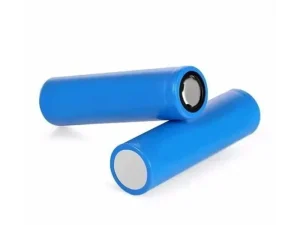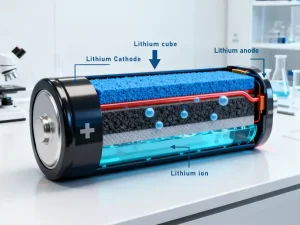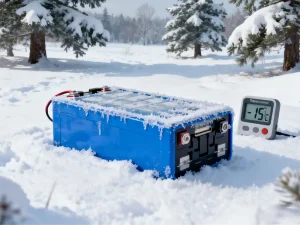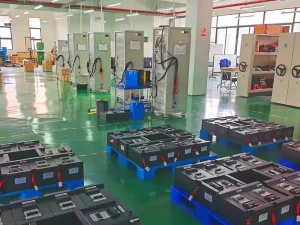Will we experience some “battery failures” during the winter? For example, the phone suddenly shuts down outdoors. Or the electric vehicle range is cut in half. These situations suddenly put us in trouble. Without doubt, we are eager to solve this problem. At the same time, we could not help but guess, “Is the battery ‘frozen’?” However, can lithium ion batteries freeze? Does cold weather affect lithium batteries? There are some analyses and solutions.
What Is A Lithium-Ion Battery?
Lithium-ion batteries represent a class of high-performance, rechargeable power sources. Their operation relies on a fundamental principle. The reversible shuttling of lithium ions between the electrodes is the direct mechanism for storing and releasing energy. During discharge, these ions flow from the negative electrode (anode) to the positive electrode (cathode) through an electrolyte, releasing electrical energy to an external circuit. They are the “heart” of modern portable electronic devices and electric vehicles.

Working Principle
You can imagine a “rocking chair” inside the lithium-ion battery, with the lithium ions as the “children” sitting on it.
- When charging, an external power source pushes these “little friends” (lithium ions) from the positive electrode, through the electrolyte, and finally “sits” on the negative electrode. At this time, the battery stores energy.
- During discharge (i.e., use), the “little friends” jump from the negative electrode, pass through the electrolyte, and run back to the positive electrode. In this process, they push electrons through the external circuit. Thereby, lithium-ion batteries are able to power your mobile phone, computer, and other devices.
Therefore, the fundamental nature of charging and discharging lies in the reversible shuttling of lithium ions. We can visualize lithium ions “running” between the positive and negative electrodes. So it is also vividly called a “rocking chair battery”.

Advantages
Lithium-ion batteries have high energy density. So they can store more electricity than traditional batteries. Besides, lithium-ion batteries have no memory effect. It means that they can charge at any time. It has a low self-discharge rate. When not in use, it loses power at a slower rate. Not only that, their life cycles are long. It supports hundreds or even thousands of recharges while maintaining a high percentage of its original capacity, ensuring long-term endurance.
Disadvantages
Lithium-ion batteries incur higher costs because of their complex manufacturing processes. Its security risk is high. If thermal runaway occurs due to physical damage, overcharging, or internal short circuits, it may cause fire or explosion. So it requires a sophisticated battery management system for protection. High temperatures accelerate battery aging and performance degradation. Low temperatures significantly reduce discharge performance. It causes the lithium-ion battery to suddenly shut down in cold weather.
Can Lithium Ion Batteries Freeze?
The short answer is yes. But it is worth mentioning that it is not a typical “freeze”. Lithium-ion batteries freezing typically results in lower performance than in the normal state.

Freezing Lithium Ion Battery Conditions
Many people consider the battery to freeze into an “ice brick” at 0°C, just like water. However, batteries are not water; freezing is not that easy. The freezing of lithium-ion batteries is a complex electrochemical process. The key is not the complete solidification of the electrolyte. This process requires extremely low temperatures. But the low temperatures have a fatal impact on the movement of internal ions. So, controlling the temperature of a lithium-ion battery is very important. Here are some temperature guidelines for your reference.
Lithium-ion Battery Temperature Guidelines
- Discharge (usage) range: -20°C – 60°C(-4°F – 140°F). But performance is significantly reduced below 0°C.
- Charging: 0°C to 45°C(32°F – 113°F) – Do not charge below 0°C(32°F)! The biggest danger does not come from discharging, but from charging at low temperatures.
- Best storage: 10°C – 15°C (64°F – 84°F). Avoiding extreme temperatures is the best approach when using a lithium-ion battery.
Freezing Lithium Ion Battery Damages
Freezing lithium-ion batteries is definitely harmful to them. But what happens if a lithium battery freezes? There is a double whammy of low temperature. We can call them “performance shock” and “permanent lifespan reduction”.
“Performance Shock”
“Performance shock” is a temporary issue, and the system can typically resolve it on its own.
At low temperatures, the electrolyte thickens, becoming more viscous. Lithium-ion batteries freeze at that time. This increased viscosity acts like a thicker mud, directly hindering the movement of lithium ions. It becomes a struggle for them to complete their essential shuttle between the electrodes, slowing the entire energy transfer process. Consequently, the battery’s internal resistance rises sharply. This situation leads to a significant drop in performance. For example, mobile phones automatically shut down in cold temperatures. In winter cold weather, drones may fail to take off, and electric vehicles experience a sharp drop in range, both primarily due to reduced lithium-ion battery activity. But this is only temporary, and performance usually recovers upon returning to a warmer environment.
“Permanent Lifespan Reduction”
“Permanent lifespan reduction” represents an irreversible loss that continuously degrades the battery’s future performance. In this process, the number one killer is lithium precipitation (lithium dendrites). When charging in cold weather, lithium ions do not have time to embed into the negative electrode. So they are forced to form a metallic lithium layer on the surface. There are several damages.
- Permanent capacity loss. The deposited lithium no longer participates in the cycle, and the battery’s power decreases as it is used. The permanent loss of this active lithium leads to an irreversible decrease in the battery’s available capacity. After a single charge, the battery may never return to 100% of its original capacity.
- Internal short circuit. Lithium dendrites may pierce the separator and cause a short circuit. Internal short circuits can generate a large amount of heat in an instant. This can trigger a chain of exothermic reactions inside the battery, leading to “thermal runaway”. These reactions can eventually cause the battery to smoke, catch fire, or even explode.
- Deterioration of battery performance. Lithium plating reactions consume available lithium ions. They may block the pores of the negative electrode, further increasing the battery’s internal resistance. This will cause the battery’s discharge voltage platform to decrease. This is accompanied by a significant drop in output power, leading to a marked decline in overall device performance.
In extremely low temperatures, the electrolyte may actually freeze and expand. This situation can destroy the internal structure, causing the electrode to fall off and the diaphragm to be damaged. This permanent damage can render the battery unusable, leaving no option but to scrap it.
Furthermore, charging lithium-ion batteries below 0°C is strictly prohibited. As the primary culprit behind short battery life and safety risks, a Battery Management System (BMS) is essential. That’s why all high-quality lithium-ion battery packs incorporate one. One of its core functions is to cut off the charging circuit and refuse charging when it detects the temperature is below the threshold (usually 0°C to 5°C), thereby protecting the safety of the battery and users at the hardware level.
Lithium-Ion Battery Winter Storage
Now, we know the damage caused by freezing lithium-ion batteries. But what can we do to keep lithium batteries in good condition in cold weather? Here are some suggestions.

- Before charging, warm up first. If you bring in a cell phone, laptop, or tool battery from outside, be sure to wait until it returns to room temperature before charging.
- Avoiding prolonged exposure. Do not leave electronic devices or electric vehicles parked outdoors in the cold for long periods of time. When parking, try to park in an underground parking lot or garage. When spending time outside, keep your device batteries in your pockets to help keep them warm with your body heat.
- Charging electric vehicles scientifically. Charge electric cars immediately after parking, if possible. Because the battery package temperature is high, the charging efficiency is high. To counter the cold, most EVs allow drivers to remotely preheat the battery with a simple command before setting off or charging, ensuring better readiness. When planning your trip, leave room for a “discount” on battery life.
- Solve sudden freezing lithium-ion battery problems. Do not repeatedly try to restart the computer. You should transfer it indoors to a warm environment and let it warm up. Using external heat sources such as hair dryers and heat packs for direct heating is forbidden. Because it can cause local overheating and become dangerous.
Conclusion
Lithium-ion batteries can freeze in cold weather. It is not a typical “freeze”. Lithium-ion batteries freezing typically results in lower performance than in the normal state. In the cold weather, lithium fails to work and poses potential risks. But the performance degradation and security risks hidden behind it are far more worthy of vigilance than the surface phenomena. So it is important to remember these key tips. For example, low temperature use will cause “shock”, but we can solve this problem in a short time. Bring the “shocked” devices back to a warm environment, and they can recover. Charging at low temperatures is “suicidal” and is absolutely prohibited. It can cause fire and even an explosion.
By understanding and following these simple guidelines, you can not only extend the battery life of your favorite devices but also ensure safety and peace of mind during cold weather.
